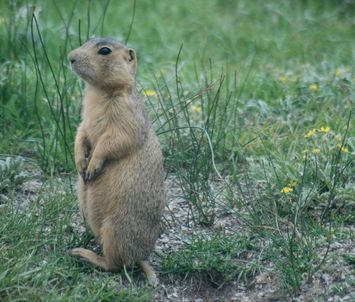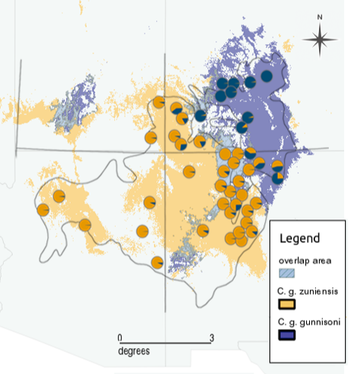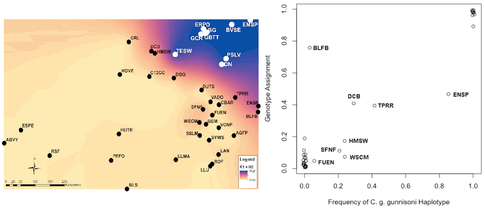|
Vertical Divider
|
|
Vertical Divider
In many cases, genetic information about species identity are in conflict with morphological or other data--and such conflict is often due to the biological reality that species do not diverge instantaneously. For this reason, any attempt to classify species or subspecies should include as many types of data as possible. Below (left) are the combined results from ecological niche modeling of the two subspecies (projected niche for each subspecies in colors; actual range in gray outline), overlaid by data from 18 nuclear microsatellites (pie charts represent genotype composition of the two genetic clusters), which both support to the hypothesis of genetically and ecologically distinct subspecies. A kriging generated map (below, middle) shows the transition from the montane genetic cluster (northeast corner, in blue) to the desert genetic cluster (tan color) with a narrow transition zone (displayed in pink).
Nuclear and mitochondrial genetic signatures often differ. We examined the correspondence between the two by plotting the frequency of the ‘montane’ microsatellite cluster against the frequency of the ‘montane’ mitochondrial haplotype (above right). There is very close agreement in most populations, with the exceptions occurring in populations that fall along the geographical boundary between subspecies. Ecological differentiation was also demonstrated in a Principal Component Analysis of temperature and precipitation for each of our 48 sampling sites. Coupled with divergence in morphology, the evidence for distinct subspecies is multifaceted.
Reference: L.C. Sackett, A. Seglund, R.P. Guralnick, M.M. Mazzella, D.M. Wagner, J.D. Busch, A.P. Martin 2014. Evidence for two subspecies of Gunnison’s prairie dogs (Cynomys gunnisoni), and the general importance of the subspecies concept. Biological Conservation 174: 1-11. doi: http://dx.doi.org/10.1016/j.biocon.2014.03.010. Download PDF
Collaborators:
Andy Martin, University of Colorado
Amy Seglund, Colorado Parks and Wildlife
Rob Guralnick, University of Florida
Dave Wagner, Northern Arizona University
Joe Busch, Northern Arizona University
Collaborators:
Andy Martin, University of Colorado
Amy Seglund, Colorado Parks and Wildlife
Rob Guralnick, University of Florida
Dave Wagner, Northern Arizona University
Joe Busch, Northern Arizona University



